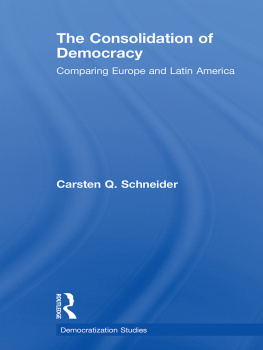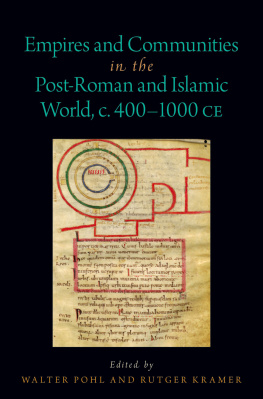A Century of Banking Consolidation in Europe: The History and Archives of Mergers and Acquisitions
First published 2001 by Ashgate Publishing
Published 2016 by Routledge
2 Park Square, Milton Park, Abingdon, Oxon OX14 4RN
711 Third Avenue, New York, NY 10017, USA
Routledge is an imprint of the Taylor & Francis Group, an informa business
Copyright Manfred Pohl, Teresa Tortella, Herman van der Wee and the contributors, 2001
The authors have asserted their moral right under the Copyright, Designs and Patents Act, 1988, to be identified as the authors of this work.
All rights reserved. No part of this book may be reprinted or reproduced or utilised in any form or by any electronic, mechanical, or other means, now known or hereafter invented, including photocopying and recording, or in any information storage or retrieval system, without permission in writing from the publishers.
Notice:
Product or corporate names may be trademarks or registered trademarks, and are used only for identification and explanation without intent to infringe.
British Library Cataloguing in Publication Data
A Century of Banking Consolidation in Europe: The History and
Archives of Mergers and Acquisitions.
(Studies in Banking History)
1. Bank mergersEuropeHistoryCongresses.
I. Pohl, Manfred, 1944-. II. Tortella, Teresa. III. Wee, Herman
van der, 1928-.
332.16
Library of Congress Cataloging-in-Publication Data
A century of banking consolidation in Europe: the history and archives
of mergers and acquisitions/edited by Manfred Pohl, Teresa Tortella and
Herman van der Wee
p. cm.
Includes index.
ISBN 0-7546-0263-X (alk. paper)
1. Bank mergersEurope. 2. Banks and bankingEuropeHistory.
I. Pohl, Manfred, 1944-. II. Tortella, Teresa. III. Wee, Herman van der.
HG1722.C46 2000
332.6dc21 00-44198
ISBN 13: 978-0-7546-0263-7 (hbk)
Contents
Youssef Cassis (University of Grenoble)
Gabriel Tortella (University of Alcal, Madrid)
Teresa Tortella (Banco de Espaa, Madrid)
Edwin Green (HSBC Holdings pic, London)
Eric Bussire (University of Artois)
Ginette Kurgan-van Hentenryk (Universit Libre de Bruxelles)
7 The Banking Crisis and its
Implications for Swiss Banking Legislation in the 1930s
Patrick Halbeisen (Schweizerische Nationalbank, Zrich)
Joaquin Lopez Madruga (European Commission, Brussels)
David Kynaston (University of Leeds)
Charles W. Munn (Chartered Institute of Bankers in Scotland, Edinburgh)
Alan Cameron (Bank of Scotland, Edinburgh)
Ton de Graaf (ABN AMRO, Amsterdam)
Gerald D. Feldman (University of California, Berkeley)
Hubert Bonin (Institut d'etudes politiques de Bordeaux)
Maurice Hamon (Compagnie de Saint-Gobain, Paris)
Eric Whittle (Bank of London and South America, BOLSA)
Carlos Manchal (Universidad Carlos III, Madrid) and Gail D. Triner (Rutgers University, New Brunswick, NJ)
Geoffrey Jones (University of Reading)
Manfred Pohl (EABH, Frankfurt am Main)
This book contains the papers and comments presented at the conference of the European Association for Banking History held in Madrid, Spain, on 1314 June 1997. This colloquium took place at the headquarters of the Banco de Espaa, the Spanish central bank, which hosted and organized the meeting jointly with the EABH. The title of the conference was A Century of Consolidation in Europe: The History and Archives of Mergers and Acquisitions.
This was the first EABH conference bringing together both archivists and historians, and was attended by more than 90 people including some representatives of banks. The meeting was opened by the governor of the Banco de Espaa, Dr Luis Angel Rojo, who made the inaugural speech, and also presented the second biennial Young Scholar Prize of the EABH, which was shared between Maria Angeles Pons, University of Valencia, and Monika Dickhaus, University of Bielefeld.
The subject of the colloquium proved to be an interesting one and there were very lively discussions following every session. In fact since the conference was held, mergers and acquisitions have been taking place among many of the European countries banks and indeed, to a large degree, within the Spanish banking system.
Greatest thanks are due to all the participants, in particular the authors of the papers, the people who chaired and made comments and to the members of the Protocol Service and the Archives within the Banco de Espaa, as well as the staff of the EABH for making this colloquium possible.
Manfred Pohl
Teresa Tortella
Herman van der Wee
PART I
History and Archives of Consolidation in European Banking: General Trends and some Case Studies
CHAPTER ONE
Introduction: A Century of Consolidation in European Banking - General Trends
Youssef Cassis
Consolidation rather than concentration has been chosen as the theme of the conference from which this book has issued. The two notions have much in common - both point to the idea of a larger share of the banking business in the hands of a smaller number of banks. There is no doubt that several common trends are likely to be identified whether a paper deals with concentration or consolidation in European banking. There are, however, differences, which this chapter will try to emphasize. In particular, consolidation puts greater emphasis on the microeconomic level, on specific banking institutions rather than on macroeconomic implications, though the latter should not be overlooked.
At first sight the outcome of a century of consolidation is strikingly similar across Europe. In all countries, banking systems have become dominated by a handful of giant, universal-type banks, most of which were already large and powerful institutions a hundred years ago. The major changes have been the decrease in the number of such banks and their increased internationalism and universalism. In some respects, the history of banking consolidation is therefore the history of a select group of large banks which have managed to maintain or to gain dominance over the industry, often - though not always - through mergers and acquisitions. In other respects, however, it overlaps with the history of the banking sector and its interaction with the economy as a whole.
The object of this chapter is to highlight some of the general trends underlying this consolidation process. Given the space available and the huge scale of the subject, such a presentation can only be general and tentative, and serve as a general introduction to the more specific topics which are discussed in subsequent chapters of this book. Despite the apparent common outcome of a century of consolidation in European banking, different routes have been followed and there still remain substantial differences. Moreover, consolidation is an ongoing process, which has gathered pace in the late 1990s. The emphasis of the paper will be on the common features displayed by the European experience rather than on national peculiarities. However, in order to take account of the diversity of this European experience, a broad comparative perspective will be maintained throughout. To this end, six questions will be addressed, each related to commonly perceived trends in the consolidation movement in European banking.











